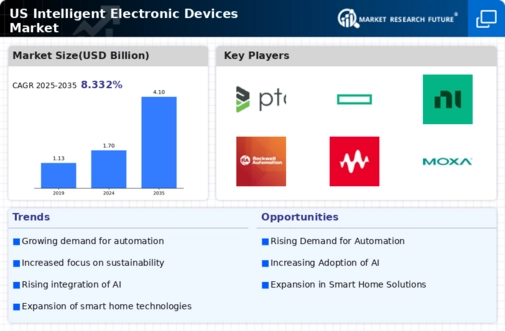Expansion of IoT Ecosystem
The expansion of the Internet of Things (IoT) ecosystem is significantly influencing the intelligent electronic-devices market. As more devices become interconnected, the demand for intelligent devices that can communicate and share data is increasing. In the US, the number of connected devices is expected to exceed 30 billion by 2025, creating vast opportunities for innovation. This interconnectedness enhances user convenience and enables advanced functionalities, such as remote monitoring and control. Consequently, the growth of the IoT ecosystem is likely to drive the adoption of intelligent electronic devices, fostering a more integrated and efficient technological landscape.
Advancements in AI Technology
The intelligent electronic-devices market is experiencing a surge due to rapid advancements in artificial intelligence (AI) technology. AI integration enhances device functionality, enabling smarter decision-making and automation. For instance, AI algorithms can analyze user behavior, leading to personalized experiences. The market for AI in consumer electronics is projected to reach $35 billion by 2026, indicating a robust growth trajectory. This trend is likely to drive demand for intelligent devices that leverage AI capabilities, thereby transforming user interactions and operational efficiencies. As AI continues to evolve, it is expected to play a pivotal role in shaping the future of the intelligent electronic-devices market.
Increased Focus on User Experience
The intelligent electronic-devices market is witnessing an increased focus on user experience, which is becoming a key differentiator among manufacturers. Companies are investing in research and development to create intuitive interfaces and seamless interactions. Enhanced user experience not only attracts consumers but also fosters brand loyalty. Data indicates that 80% of consumers prioritize user-friendly designs when selecting electronic devices. This emphasis on user experience is likely to drive innovation and competition within the market, as companies strive to meet evolving consumer expectations. As a result, the intelligent electronic-devices market is expected to continue evolving, with a strong emphasis on user-centric design.
Growing Demand for Energy Efficiency
Energy efficiency has become a critical driver in the intelligent electronic-devices market. Consumers are increasingly seeking devices that minimize energy consumption while maximizing performance. This shift is partly driven by rising energy costs and environmental concerns. According to recent data, energy-efficient devices can reduce energy usage by up to 30%, appealing to eco-conscious consumers. Manufacturers are responding by developing smart devices that optimize energy use, such as smart thermostats and energy-efficient appliances. This trend not only benefits consumers financially but also aligns with broader sustainability goals, further propelling the growth of the intelligent electronic-devices market.
Rising Consumer Awareness of Smart Technologies
Consumer awareness regarding the benefits of smart technologies is on the rise, acting as a catalyst for the intelligent electronic-devices market. As individuals become more informed about the advantages of automation, convenience, and enhanced functionality, the demand for intelligent devices is expected to grow. Surveys indicate that approximately 70% of consumers are interested in smart home technologies, reflecting a shift in consumer preferences. This heightened awareness is prompting manufacturers to innovate and market their products more effectively, thereby stimulating growth in the intelligent electronic-devices market. The trend suggests a promising future for smart technology adoption.






















Leave a Comment